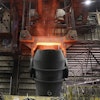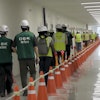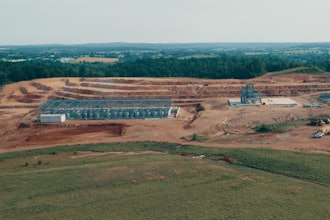Eric King has made many an extreme machine cry uncle over his long career as a testing engineer. But nothing comes close to his current charge, Harriet, the world’s largest and most powerful gas turbine. “What we are doing is akin to the hardest military boot camp,” King says. “There is nothing like this anywhere in the world. We can simulate conditions ranging from the Arabian Desert to the mountains of Colorado, and run Harriet through extreme events it will likely never see in service.”
GE is investing over $1 billion in Harriet. The turbine can generate 600 megawatts when combined with a steam generator, enough to power the equivalent of 600,000 U.S. homes. The company also spent additional $185 million on King’s high-tech boot camp, a unique full-speed, full-load test bed at GE Power & Water in Greenville, S.C. “Here we can really see what it’s made off,” King says. “In field testing, we measure data and extrapolate. With this test stand, we measure data and then verify it.”
Since the test bed is not connected to the grid, King and his team of testing engineers can do things that could otherwise destabilize or damage the power network, like running the turbine at 110 percent of its rated speed. Instead of generating electricity, the turbine exhales hot air at a speed equivalent to a Category 5 hurricane. “We could fill the Goodyear blimp in about 10 seconds,” says Brad Carey, the engineering manager for Harriet.
In fact, the turbine is so large and powerful, and the tests are so extreme that GE had to build a dedicated gasworks that can store 180,000 gallons of liquefied natural gas to feed it, and North America’s largest railroad turntable to maneuver it inside the test bed. “The city of Greenville is a light industrial and residential area,” Carey says. “It does not have the infrastructure to give us the gas flow rates we need for this type of equipment.”
Made in France, the first Harriet arrived for testing in April last year. GE engineers placed some 5,000 measuring instruments and sensors on the turbine, and another 2,000 on a compressor validation rig that must absorb Harriet’s 500,000 horsepower. The detectors produced nearly 5 terabytes of data, about half the content of the printed collection of the U.S. Library of Congress. “The test stand allows us to obtain information about the turbine about a year earlier than in the normal development cycle,” Carey says.
The engineers feed the data into custom-made, proprietary software that allows them to monitor the immediate health of the turbine and measure parameters like output heat rate and emissions.
In just 3 months, they ran the turbine through operations that would normally take years to encounter in the field. They tested it at the maximum power output and simulated extreme events like severe grid instability caused by the oversupply of power, and observed the turbine respond and bring the grid back to normal. “You can’t do his in the field without wrecking the grid,” King says. “This hasn’t been done before. More than 50 customers flew in to see the test, including representatives from France’s Électricité de France.”
The testing had three phases. The validation stage took the turbine through its normal operations, the demonstration stage studied the machine’s fuel and load flexibility, and growth phase took the validation rig beyond its limits.
The tests will help engineers to fine tune Harriet before the first one starts generating producing electricity in France next year. GE also already has 15 backlog orders for the turbine from customers in the U.S., Japan and the E.U. “Knowing what each component does will also allow us to make changes and improve the turbine in the future,” Carey says.
For more stories like this, check out GE Reports.





















